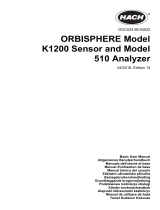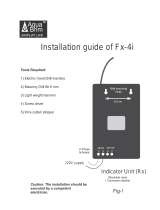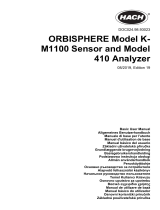
Navigator 500
Hydrazine analyzer
OI/AHM550–EN Rev. A 1
Contents
1 Health & Safety ................................................................3
1.1 Safety precautions ...................................................3
1.2 Potential safety hazards ...........................................3
1.2.1 Navigator 550 hydrazine wet-section –
electrical .......................................................3
1.2.2 Navigator 550 hydrazine wet-section –
chemical reagents .........................................3
1.2.3 Navigator 540 transmitter – electrical ............3
1.3 Safety standards ......................................................3
1.4 Safety conventions ...................................................4
1.5 Symbols ...................................................................4
1.5.1 Navigator 550 hydrazine wet-section ............4
1.5.2 Navigator 540 transmitter .............................5
1.6 Product recycling and disposal (Europe only) ...........5
1.6.1 End-of-life battery disposal ...........................5
1.7 Restriction of Hazardous Substances (RoHS) ...........5
2 Overview ..........................................................................6
2.1 Navigator 550 hydrazine wet-section .......................6
2.2 Navigator 540 transmitter .........................................7
3 Installation .......................................................................8
3.1 Installing the wet-section ..........................................8
3.1.1 Sample requirements ....................................8
3.1.2 Location .......................................................8
3.1.3 Mounting the wet-section .............................9
3.1.4 Connecting the external sample inlet line and
drains .........................................................10
3.1.5 Connecting the standard solution 2 (high) and
reagent tubing ............................................11
3.2 Installing the transmitter .........................................12
3.2.1 Transmitter optional accessories .................12
3.2.2 Transmitter location ....................................12
3.2.3 Panel mounting ...........................................12
3.2.4 Pipe mounting ............................................13
3.2.5 Wall mounting .............................................13
3.3 Multiple wet-section setup .....................................13
3.4 Electrical connections – wet-section .......................14
3.4.1 Accessing the wet-section PCB ..................14
3.4.2 Wet-section PCB connections ....................15
3.5 Electrical connections – transmitter ........................16
3.5.1 Accessing the transmitter connection board 17
3.5.2 Transmitter connections .............................18
3.5.3 Digital I/O, relays and analog output
connections ................................................18
4 Setup .............................................................................19
4.1 Transmitter start-up ...............................................19
4.2 Setting up the wet-section .....................................19
4.3 Setting flow rates ...................................................20
4.3.1 Checking the standard solution 2 (high) flow
rate .............................................................20
4.3.2 Sample flow rate .........................................22
5 Calibration ..................................................................... 23
5.1 Performing a calibration for the first time ................ 23
5.2 Calibration options ................................................. 24
5.2.1 Scheduled calibration ................................. 24
5.2.2 Monitoring calibration progress ................... 24
5.2.3 Abort calibration ......................................... 25
5.2.4 Sensor efficiency ........................................ 25
5.3 Recovery period .................................................... 25
6 Operation overview – transmitter ................................. 26
6.1 Front panel keys .................................................... 26
6.2 Transmitter operation modes ................................. 27
6.3 Operator menus .................................................... 27
6.4 Navigation overview ............................................... 28
6.5 Operating mode ..................................................... 28
6.6 View mode ............................................................ 30
6.7 Log mode .............................................................. 31
6.7.1 Calibration log entries ................................. 32
6.8 Logging ................................................................. 33
6.8.1 SD card / USB stick ................................... 33
6.8.2 SD card / USB stick insertion and removal . 34
6.8.3 Archive file types ......................................... 34
6.8.4 Data files .................................................... 34
6.8.5 Log files ...................................................... 35
6.8.6 Daylight saving ........................................... 35
6.9 Password security and Access Level ..................... 36
6.9.1 Setting passwords ...................................... 36
6.9.2 Access Level .............................................. 36
6.10 Display icons ......................................................... 37
6.10.1 Diagnostic icons ........................................ 37
6.10.2 Title bar icons ............................................ 37
6.10.3 Log icons ................................................... 38
6.10.4 Status bar icons ......................................... 38
7 Menu descriptions ........................................................ 39
7.1 Menu overview ...................................................... 39
7.1.1 Calibrate ..................................................... 40
7.1.2 Sensor Setup ............................................. 41
7.1.3 Device Setup .............................................. 42
7.1.4 Display ....................................................... 44
7.1.5 Input/Output ............................................... 46
7.1.6 Process Alarm ............................................ 48
7.1.7 Media Card ................................................ 49
7.1.8 Communication .......................................... 50
7.1.9 Device Info ................................................. 51
7.2 Analog sources and digital input / output sources .. 52
7.2.1 Analog sources .......................................... 52
7.2.2 Digital output sources ................................. 52
7.2.3 Digital input sources ................................... 52



























